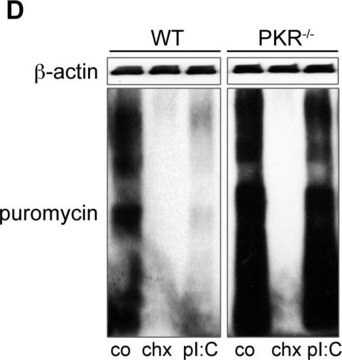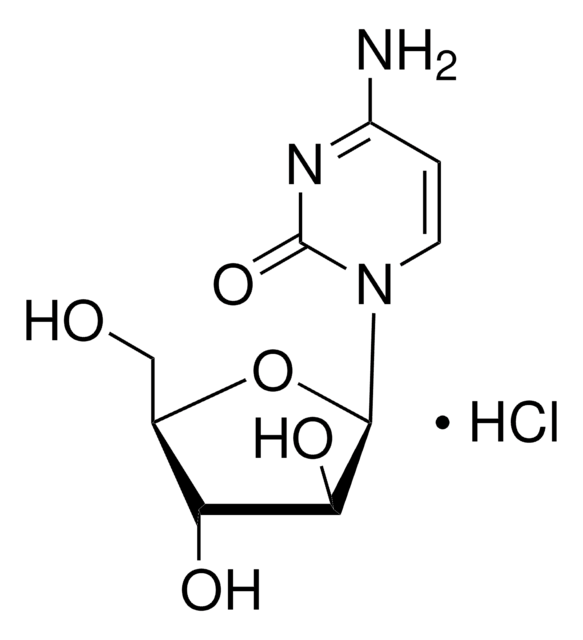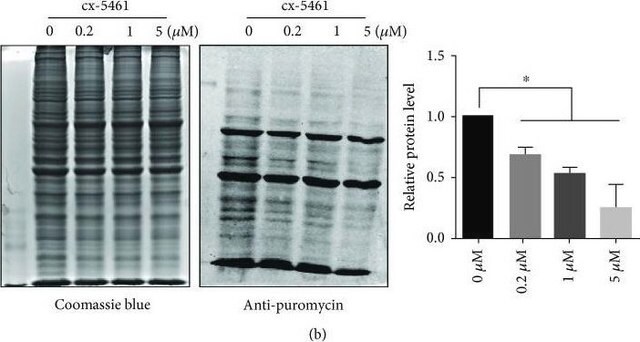P8333
Anti-Protein Kinase Cδ antibody produced in rabbit
whole antiserum
Sinônimo(s):
Anti-PKC δ
Faça loginpara ver os preços organizacionais e de contrato
About This Item
Produtos recomendados
fonte biológica
rabbit
conjugado
unconjugated
forma do anticorpo
whole antiserum
tipo de produto de anticorpo
primary antibodies
clone
polyclonal
contém
15 mM sodium azide
reatividade de espécies
rat
técnica(s)
dot blot: 1:50,000
microarray: suitable
western blot: 1:10,000 using rat brain extract
nº de adesão UniProt
Condições de expedição
dry ice
temperatura de armazenamento
−20°C
modificação pós-traducional do alvo
unmodified
Informações sobre genes
rat ... Prkcd(170538)
Categorias relacionadas
Descrição geral
Protein Kinase C (PKC) is a family of serine/threonine (Ser/Thr)-specific protein kinases. PKC is a phospholipid-dependent enzyme, activated by the lipid 1,2-diacylglycerol (DAG). The protein kinase C delta (PKC δ) isoenzyme appears to be widely expressed in the brain, lung, heart, spleen, liver, ovary, pancreas, thymus, adrenal gland, skin and rat embryonic fibroblasts, and is expressed in lower levels in certain mouse fibroblasts. PKD is also located in the cytosol, nuclear compartment and in mitochondria in response to cellular stress.
Especificidade
Anti-Protein Kinase C δ specifically reacts in dot-blot immunoassay with PKC δ peptide conjugated to BSA with 1-ethyl-3-(3-dimethylamino-propyl)-carbodiimide (EDCI).
Imunogênio
Synthetic peptide corresponding to the C-terminal variable (V5) region (amino acids 662-673) of rat PKC δ coupled to KLH with glutaraldehyde.
Aplicação
Anti- protein kinase c δ antibody may be used in:
- immunoprecipitation
- immunohistochemistry
- immunoblotting
- ELISA
- chemiluminescence detection systems to detect PKC δ
- dot-blot immunoassay
Applications in which this antibody has been used successfully, and the associated peer-reviewed papers, are given below.
Western Blotting (1 paper)
Western Blotting (1 paper)
Ações bioquímicas/fisiológicas
Protein Kinase C isotype δ (PKCδ) modulates the inflammatory response. It acts as a signal transducer of several signaling pathways. Hence it can be considered as a vital therapeutic target to treat sepsis induced-lung injury. In sepsis, PKCδ participates in platelet-mediated activation. Overexpression and stimulation of PKC δ leads to cell division arrest in Chinese hamster ovary (CHO) cells and growth inhibition of NIH3T3 cells.
Protein kinase C (PKC) has a pivotal role in cell growth and differentiation, modulation of neurotransmission, signal transduction and oncogenesis. Anti-protein kinase c δ antibody can be used for studying the differential tissue expression and intracellular localization of PKC δ. It can also be used in western blotting and microarray.
forma física
Rabbit Anti-Protein Kinase C δ is supplied as liquid containing 0.1% sodium azide as preservative.
Armazenamento e estabilidade
For continuous use, store at 2-8 °C for up to one month. For extended storage freeze in working aliquots. Repeated freezing and thawing is not recommended.Storage in "frost-free" freezers is not recommended. If slight turbidity occurs upon prolonged storage, clarify the solution by centrifugation before use.
Exoneração de responsabilidade
Unless otherwise stated in our catalog or other company documentation accompanying the product(s), our products are intended for research use only and are not to be used for any other purpose, which includes but is not limited to, unauthorized commercial uses, in vitro diagnostic uses, ex vivo or in vivo therapeutic uses or any type of consumption or application to humans or animals.
Não está encontrando o produto certo?
Experimente o nosso Ferramenta de seleção de produtos.
Escolha uma das versões mais recentes:
Já possui este produto?
Encontre a documentação dos produtos que você adquiriu recentemente na biblioteca de documentos.
Sean M Crosson et al.
Molecular therapy. Methods & clinical development, 10, 1-7 (2018-08-04)
Adeno-associated virus (AAV) is one of the most promising gene therapy vectors and is widely used as a gene delivery vehicle for basic research. As AAV continues to become the vector of choice, it is increasingly important for new researchers
Manuela Cerezo et al.
European journal of pharmacology, 522(1-3), 9-19 (2005-10-06)
The present study was designed to investigate the possible changes of protein kinase A (PKA) and different isoforms of protein kinase C (PKC): PKC alpha, PKC delta and PKC zeta after naloxone induced morphine withdrawal in the heart. Male rats
Ikuko Koyama-Honda et al.
Autophagy, 9(10), 1491-1499 (2013-07-26)
Autophagosome formation is governed by sequential functions of autophagy-related (ATG) proteins. Although their genetic hierarchy in terms of localization to the autophagosome formation site has been determined, their temporal relationships remain largely unknown. In this study, we comprehensively analyzed the
Protein kinase D activation induces mitochondrial fragmentation and dysfunction in cardiomyocytes
Jhun BS, et al.
The Journal of Physiology, 596(5), 827-855 (2018)
Peidu Jiang et al.
Molecular biology of the cell, 25(8), 1327-1337 (2014-02-21)
Membrane fusion is generally controlled by Rabs, soluble N-ethylmaleimide-sensitive factor attachment protein receptors (SNAREs), and tethering complexes. Syntaxin 17 (STX17) was recently identified as the autophagosomal SNARE required for autophagosome-lysosome fusion in mammals and Drosophila. In this study, to better
Nossa equipe de cientistas tem experiência em todas as áreas de pesquisa, incluindo Life Sciences, ciência de materiais, síntese química, cromatografia, química analítica e muitas outras.
Entre em contato com a assistência técnica






